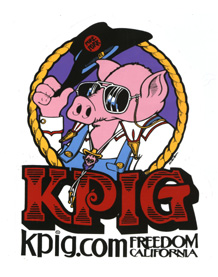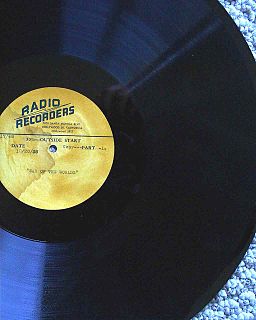Music radio is a radio format in which music is the main broadcast content. After television replaced old time radio's dramatic content, music formats became dominant in many countries. Radio drama and comedy continue, often on public radio.

Broadcasting is the distribution of audio or video content to a dispersed audience via any electronic mass communications medium, but typically one using the electromagnetic spectrum, in a one-to-many model. Broadcasting began with AM radio, which came into popular use around 1920 with the spread of vacuum tube radio transmitters and receivers. Before this, all forms of electronic communication were one-to-one, with the message intended for a single recipient. The term broadcasting evolved from its use as the agricultural method of sowing seeds in a field by casting them broadly about. It was later adopted for describing the widespread distribution of information by printed materials or by telegraph. Examples applying it to "one-to-many" radio transmissions of an individual station to multiple listeners appeared as early as 1898.

Capital London is a regional radio station owned and operated by Global as part of the Capital network.
A playlist is a list of video or audio files that can be played back on a media player either sequentially or in a shuffled order. In its most general form, an audio playlist is simply a list of songs, but sometimes a loop. The term has several specialized meanings in the realms of television broadcasting, radio broadcasting and personal computers.

Heart 96.3 is a radio station serving Bristol and surrounding areas and broadcasting on 96.3 MHz in Bristol and Weston-super-Mare. Launched in 1981 as Radio West, it was merged with neighbouring Wiltshire Radio and relaunched under the name GWR in 1985, retaining the name through several changes of ownership until rebranding in March 2009. Heart Bristol merged with sister stations in Somerset and Bath to form Heart West Country.

Broadcast automation incorporates the use of broadcast programming technology to automate broadcasting operations. Used either at a broadcast network, radio station or a television station, it can run a facility in the absence of a human operator. They can also run in a "live assist" mode when there are on-air personnel present at the master control, television studio or control room.

KRTH is a commercial radio station that is licensed to Los Angeles, California, United States and serves the Greater Los Angeles area. The station is owned by Entercom and broadcasts a classic hits format. KRTH's studios are located on Wilshire Boulevard in the Miracle Mile district of Los Angeles. The station's signal covers an extremely large area of Southern California due in part to its antenna location on Mt. Wilson. It can be heard as far south as San Diego, as far east as Moreno Valley, as far west as Santa Barbara, and as far north as Barstow. KRTH is the flagship station for the nationally syndicated program Rewind with Gary Bryan.
WPLJ is a non-commercial Contemporary Christian music radio station licensed to serve New York City. The station is owned by the Educational Media Foundation (EMF) and services the New York metropolitan area as the New York City network affiliate for K-Love. WPLJ's transmitter is located at the Empire State Building, and broadcasts over four HD Radio subchannels in addition to its analog transmission. It is one of a handful of non-commercial radio stations in the United States that operate outside of the recommended frequency range for FM radio stations of its type (88.1 MHz-91.9 MHz).

WOGL is a commercial FM radio station licensed to serve Philadelphia, Pennsylvania. The station is owned by Entercom and broadcasts a classic hits radio format. The broadcast tower used by the station is located in the Roxborough section of the city at. Studios and offices are on East City Avenue in Bala Cynwyd.

KPIG-FM is a radio station located near the city of Santa Cruz, California, United States. Founded in 1988, the studio is based in Watsonville, California, and broadcasts to the counties of Santa Cruz and Monterey. It also has a radio repeater on 94.9 MHz FM in San Luis Obispo County as KPYG. The station's logo, designed by John F. Johnson, features a sunglasses-wearing pig in farmer's clothing and a cowboy hat, as well as its branding, website and city of license. It has been owned by Stephens Media since October 2019.

WVPH is Piscataway, New Jersey's community and student-run radio station. The slogan is "Many voices, one station", and is a commercial free, freeform radio station, where the disc jockey can play and say whatever they want, as long as it goes by FCC rules and regulations.
Below is a glossary of terms used in broadcasting.

WPOW – branded Power 96 – is a commercial rhythmic CHR radio station licensed to Miami, Florida. Owned by Entercom, the station serves Miami-Dade County, the Miami-Fort Lauderdale metropolitan area, and much of surrounding South Florida. The WPOW studios are located in the Miami suburb of Miami Gardens, while the station transmitter resides in the Miami Gardens neighborhood of Andover. Besides a standard analog transmission, WPOW broadcasts over three HD Radio channels, and is available online via Radio.com.

A radio personality or radio presenter is a person who has an on-air position in radio broadcasting. A radio personality who hosts a radio show is also known as a radio host, and in India and Pakistan as a radio jockey. Radio personalities who introduce and play individual selections of recorded music are known as disc jockeys or "DJs" for short. Broadcast radio personalities may include talk radio hosts, AM/FM radio show hosts, and satellite radio program hosts.
Almost all radio stations today use some form of broadcast automation. Although some only use small scripts in audio players, a more robust solution is using a full radio automation suite. There are many commercial and free radio automation packages available.

WIOD – branded Newsradio 610 WIOD – is a commercial news/talk radio station licensed to Miami, Florida, serving the Miami metropolitan area and much of surrounding South Florida. Owned by iHeartMedia, Inc., WIOD serves as the Miami affiliate for: ABC News Radio; The Glenn Beck Program, The Rush Limbaugh Show, The Sean Hannity Show, The Schnitt Show and Coast to Coast AM; and syndicated personalities Clyde Lewis and Bill Cunningham. The WIOD studios are located in the Miami suburb of Miramar, while the station transmitter resides in nearby North Bay Village. Besides its main analog transmission, WIOD simulcasts over the HD subchannel of co-owned WBGG-FM, and streams online via iHeartRadio.
In broadcasting, rotation is the repeated airing of a limited playlist of songs on a radio station or satellite radio channel, or music videos on a TV network. They are usually in a different order each time. However, they are not completely shuffled, so as to avoid varying the time between any two consecutive plays of a given song by either too much or too little. When measuring airplay, the number of times a song is played is counted as spins.
MusicMaster is a music scheduling software produced by A-Ware Software and used by radio, Internet and television stations. Their main office is located in Dallas, Texas.

WGWE is an FM radio station licensed to Little Valley, New York. The station, with a tower atop Fourth Street in the village of Little Valley, broadcasts a loosely defined classic hits format on 105.9 MHz and operates under the ownership of the Seneca Nation of Indians.

Electrical transcriptions are special phonograph recordings made exclusively for radio broadcasting, which were widely used during the "Golden Age of Radio". They provided material—from station-identification jingles and commercials to full-length programs—for use by local stations, which were affiliates of one of the radio networks.